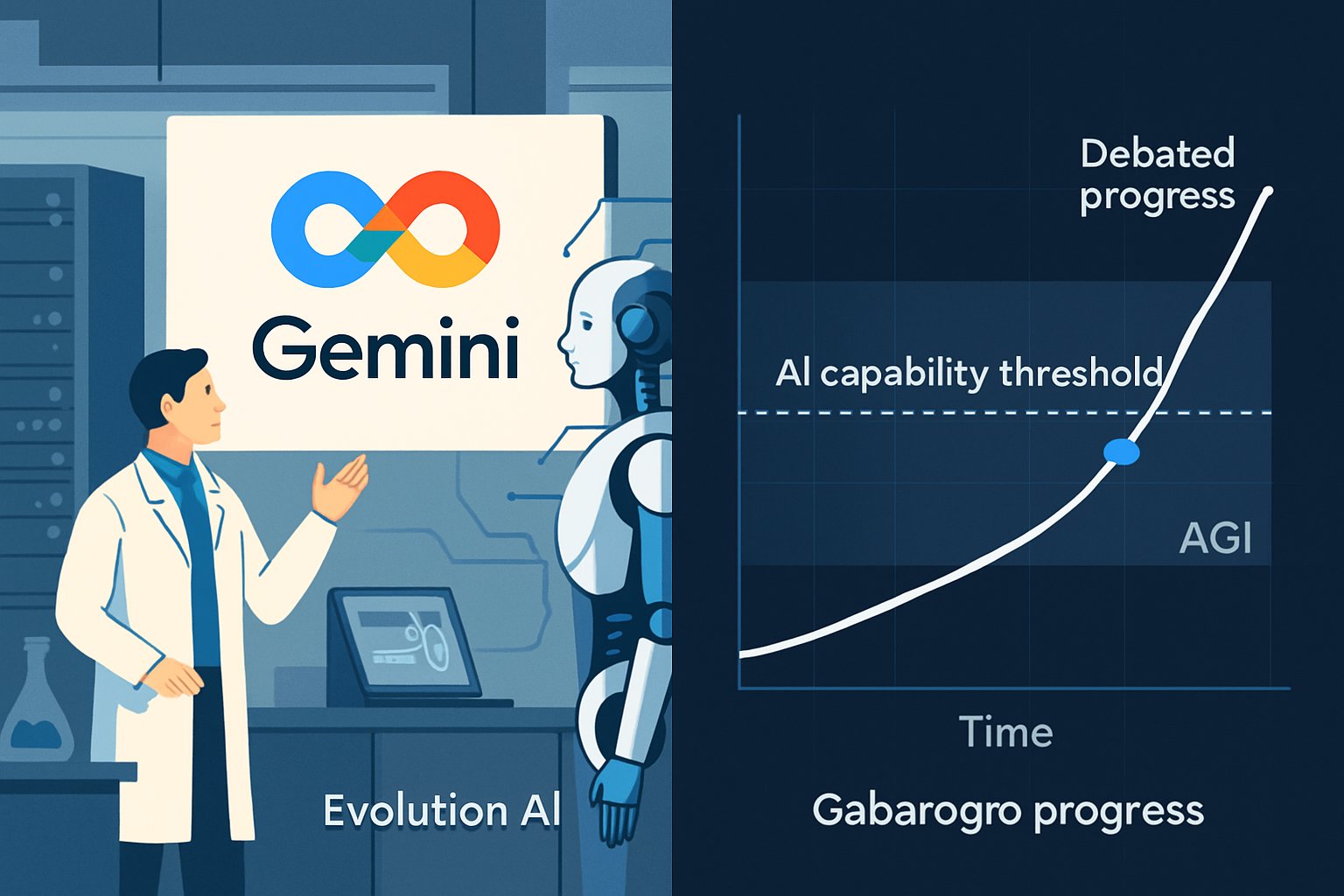
AI CERTS
2 months ago
Google’s Gemini Tests Stir AI Capability Threshold Debate
This article unpacks numbers, context, and the remaining gaps between current models and humans. Moreover, we examine AGI progress, LLM reasoning advances, and what advanced cognition really entails. Readers will also gain insights into potential business impacts and the debates shaping policy.

Additionally, professionals will discover how the AI+ Researcher™ certification can sharpen evaluation skills.
By the end, you will understand where Google truly stands on human-level reasoning claims.
Meanwhile, you will recognize why a single percentage cannot capture machine intelligence complexity.
Benchmark Claims Under Scrutiny
Google’s May 2025 I/O post showcased Gemini 2.5 surpassing rivals on LiveCodeBench and LMArena.
However, the post never mentioned an 80% completion figure or a holistic reasoning metric.
Reuters later echoed the achievements but also noted absent global measures across tasks.
Therefore, the alleged percentage appears marketing folklore rather than substantiated data.
Analysts tracking the AI capability threshold instead focus on benchmark clusters, each with unique baselines.
Consequently, models can score above humans in one arena yet stumble on everyday logic tests.
In contrast, human intelligence remains broadly consistent across domains.
These findings indicate progress is real yet uneven.
However, understanding Deep Think mechanisms clarifies the current landscape ahead.
Next, we dissect Deep Think’s architecture.
Deep Think Explained Clearly
Meanwhile, Deep Think adds parallel hypothesis streams and extended inference budgets to Gemini 2.5.
Moreover, Google claims the mode solves Olympiad-grade math by evaluating ideas for hours.
Such prolonged computation boosts reliability but raises compute costs and latency.
Therefore, some insiders view Deep Think as a stepping stone toward the AI capability threshold.
The technique exemplifies LLM reasoning improvements through systematic chain-of-thought prompting.
Additionally, it showcases advanced cognition when confronting symbolic manipulation tasks.
- Firstly, parallel agents propose diverse solution paths within milliseconds.
- Secondly, an evaluator ranks hypotheses before deeper search begins.
- Thirdly, extended tokens permit multi-step derivations beyond standard context windows.
- Finally, thought summaries let developers audit each reasoning chain.
Collectively, these mechanics expand Gemini’s problem-solving versatility.
Subsequently, accurate measurement becomes more challenging.
Therefore, the next section reviews evaluation methods.
Measuring Human Reasoning Gap
Quantifying reasoning requires clear baselines and transparent protocols.
Moreover, labs rely on task-specific benchmarks like MMLU, USAMO replicas, and LiveCodeBench.
Yet no single score captures the AI capability threshold because tasks vary widely.
For instance, Gemini 2.5 nears expert humans on MMLU, hitting 88% in internal tests.
In contrast, the model still falters on ARC-style abductive puzzles that stump pattern learners.
Consequently, AGI progress assessments must aggregate multiple dimensions, not isolate a flashy figure.
The following benchmarks illustrate the fragmented picture.
- MMLU: 88% versus 89.8% expert baseline.
- LiveCodeBench: top leaderboard position, margin unspecified.
- IMO style questions: 60% success with Deep Think enabled.
- ARC-AGI: 41% accuracy, still below human novice levels.
Overall, averages hover near the AI capability threshold on knowledge questions yet lag on abstraction puzzles.
These numbers reveal encouraging but uneven capability.
Next, expert voices add essential nuance.
Expert Opinions And Skepticism
Demis Hassabis praises recent strides yet urges better safety evaluations and broader benchmarks.
Quoc Le compares Gemini's contest wins to historic AlphaGo moments, signalling accelerated AGI progress.
However, scholars like Stuart Russell warn about jagged performance across simple everyday tasks.
They argue the AI capability threshold cannot be declared reached until consistency improves everywhere.
Additionally, Sam Altman emphasizes that AGI remains forthcoming despite spectacular benchmark spikes.
Meanwhile, independent contest organizers demand open methodologies and compute disclosures.
Consequently, skepticism tempers exuberant milestone headlines.
These perspectives illustrate a vibrant but cautious research culture.
Accordingly, businesses must weigh potential benefits against lingering unpredictability.
Reaching the AI capability threshold will require both algorithmic creativity and rigorous validation.
The upcoming section explores commercial stakes.
Business Impact Forecasts Ahead
Enterprise leaders monitor reasoning breakthroughs for competitive edge in software, finance, and science.
Moreover, Deep Think could automate complex code reviews, derivative pricing, and molecular design.
Such possibilities make the AI capability threshold a strategic planning anchor for many boards.
Consequently, vendor selection criteria increasingly prioritize demonstrable LLM reasoning reliability.
In contrast, cost models remain uncertain because extended inference inflates cloud bills.
Additionally, compliance teams debate explainability, fearing opaque chains harm audit readiness.
Professionals can enhance judgement with the AI+ Researcher™ credential, which teaches benchmark validation.
Therefore, early adopters balance upside against technical opacity.
Clear ROI demands disciplined experimentation and transparent metrics.
Subsequently, risk governance leads naturally into remaining challenges.
We now assess unresolved risks and needed safeguards.
Remaining Risks And Safeguards
Key hazards include inconsistent performance, compute emissions, and reproducibility concerns.
Moreover, long inference windows may leak proprietary data through expanded context.
Until designers curb such pitfalls, the AI capability threshold remains an aspirational marker, not an endpoint.
Nevertheless, initiatives like system cards and third-party audits increase trust.
Consequently, Google promises red-team exercises and public contest replications for Gemini upgrades.
Additionally, regulatory frameworks emerge, inspired by energy labeling and pharmaceutical trials.
In contrast, some critics fear regulations will lag rapid AGI progress.
Effective governance blends internal controls, external oversight, and professional education.
For example, AI-safety staff holding the AI+ Researcher™ certificate can audit model rollouts.
These safeguards mitigate the most acute short-term dangers.
Consequently, attention can return to trajectory forecasting.
The final section synthesizes lessons and outlines next steps.
Conclusion And Next Steps
Google’s latest benchmarks showcase undeniable momentum toward richer machine reasoning.
However, evidence shows that capability gains remain patchy across diverse tasks.
Consequently, the AI capability threshold should be treated as a moving, multidimensional target.
AGI progress will accelerate when models achieve consistent transfer and transparent evaluation.
Meanwhile, LLM reasoning research continues optimizing the chain-of-thought and tool integration.
Furthermore, advanced cognition milestones must align with reproducible, energy-aware methods.
Professionals can future-proof careers by earning the AI+ Researcher™ certification and joining multidisciplinary audit teams.
Explore our related analyses to stay ahead of rapid developments.



